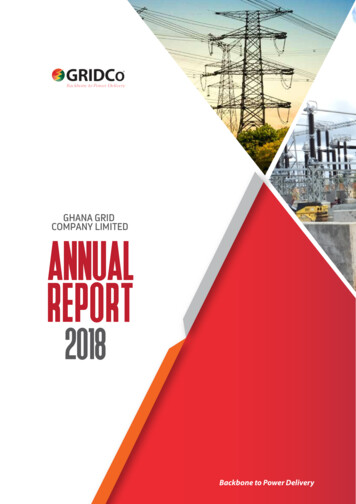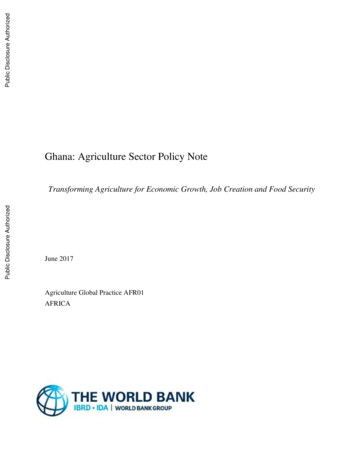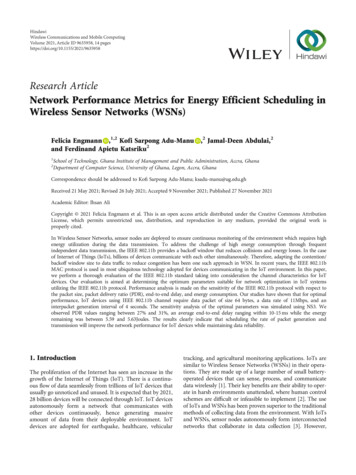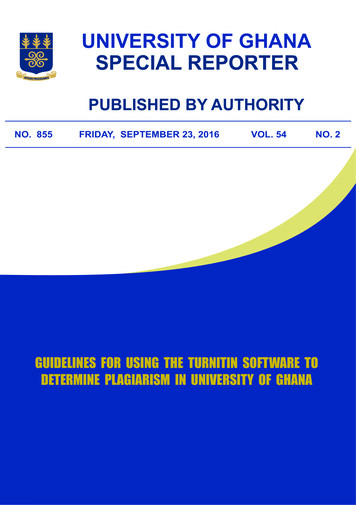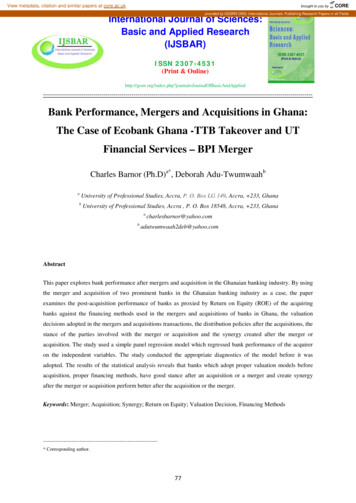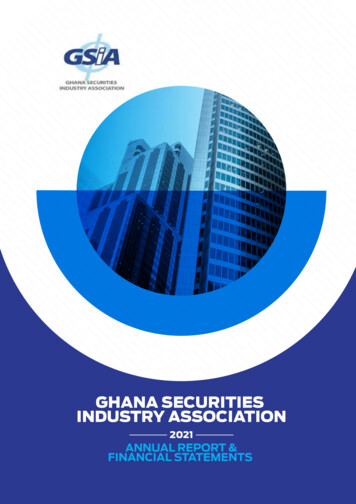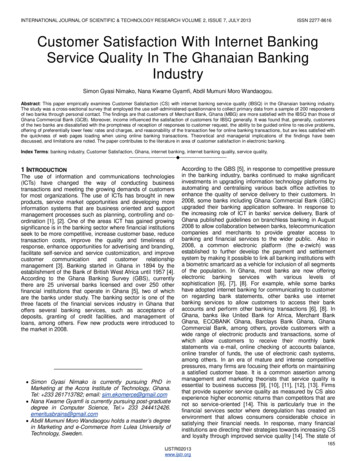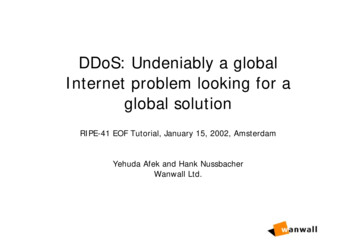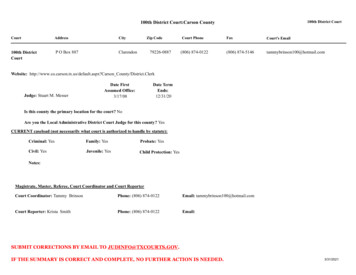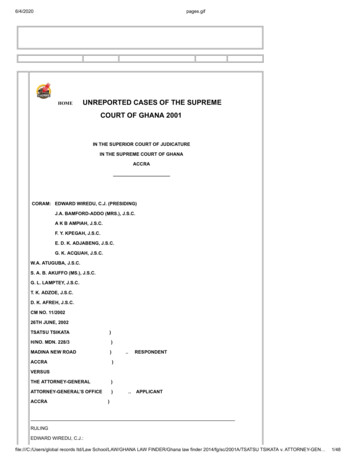
Transcription
6/4/2020pages.gifHOMEUNREPORTED CASES OF THE SUPREMECOURT OF GHANA 2001IN THE SUPERIOR COURT OF JUDICATUREIN THE SUPREME COURT OF GHANAACCRACORAM: EDWARD WIREDU, C.J. (PRESIDING)J.A. BAMFORD-ADDO (MRS.), J.S.C.A K B AMPIAH, J.S.C.F. Y. KPEGAH, J.S.C.E. D. K. ADJABENG, J.S.C.G. K. ACQUAH, J.S.C.W.A. ATUGUBA, J.S.C.S. A. B. AKUFFO (MS.), J.S.C.G. L. LAMPTEY, J.S.C.T. K. ADZOE, J.S.C.D. K. AFREH, J.S.C.CM NO. 11/200226TH JUNE, 2002TSATSU TSIKATA)H/NO. MDN. 228/3)MADINA NEW ROAD)ACCRA.RESPONDENT)VERSUSTHE ATTORNEY-GENERAL)ATTORNEY-GENERAL’S OFFICE)ACCRA.APPLICANT)RULINGEDWARD WIREDU, C.J.:file:///C:/Users/global records ltd/Law School/LAW/GHANA LAW FINDER/Ghana law finder 2014/fg/sc/2001A/TSATSU TSIKATA v. ATTORNEY-GEN 1/48
6/4/2020pages.gifMy opinion in this review application is expressed in the ruling to be read by my brother Acquah, J.S.C. onour joint behalf.ACQUAH, J.S.C.:On 28th February 2002, this Court by a 5:4 decision entered judgment for the plaintiff for1. A declaration that there is no Fast Track Court with jurisdiction to try Criminal cases established underthe Constitution of the Republic of Ghana, and there is therefore no constitutional foundation for the plaintiffto be prosecuted before such Court.2. A declaration that the oral demand by agents of the Defendant to plaintiff to appear before a Fast TrackCourt, when no such Court for trial is provided for in the Constitution of the Republic of Ghana, is aninfringement on Article 125 and 126 of the Constitution establishing the Judiciary.3. An injunction against the Defendant and their agents restraining them from seeking to proceed with a trialof the Plaintiff before the purported Fast Track Court.4. A declaration that the summons signed by a Justice of Appeal served on the Plaintiff commanding him “inthe President’s name to appear in person before this Court" is in contravention of Articles 1(i) and 125 (i) ofthe Constitution.5. A declaration that there is no Fast Track High Court established under the 1992 Constitution of theRepublic of Ghana and therefore a summons to appear before such a Court is null and void.The reasons for the decision were reserved for the 20th March 2002.However, before the delivery of the reasons, the Attorney General on 1st March 2002 filed an application fora review of the majority decision. In an accompanying statement of case, he contented that:“In view of the exceptional circumstances which have resulted in miscarriage of justice by the ruling, thismatter must be looked at again by review”.He proceeded to expound the particulars of the exceptional circumstances in the following words:“1. It is the case of the applicant that the decision of the Court is a retrograde step that strikes at the heart ofthe Administration of Justice in this country and considering the far reaching effect this will have on theAdministration of Justice in the Land, having regard to numerous cases that have been disposed of at theFast Track High Court, and since there is only a very narrow majority decision, there is absolute need tohave a second hard look at this matter again.2. It is the case of the applicant that since the Supreme Court itself in the case of the Republic v. Selormeysaw it fit in the ruling to remit the case back to the court below which is the Fast Track High Court for trial tocontinue in the said Fast Track Court, the same Court cannot now rule that this Court is unknown to theConstitution to warrant granting the Plaintiff/respondent the reliefs he sought.3. The ruling in the Republic v. Selormey by the Supreme Court and the ruling in the present case by thesame court are surely contradictory and inconsistent with each other.4. The Supreme Court, the highest court of the land has a duty to ensure certainty in the law and in thepresent uncertainty and apparent confusion that the decisions in these two cases show, an exceptionalcircumstance has arisen which has occasioned a miscarriage of justice and therefore the justice of thesituation demands that this matter be looked at again so that the speedy computer-based recordtranscription system which is geared to efficient case management and speedy disposal of cases willbecome a permanent feature of our Administration of justice.”In his statement of case, opposing the application for review, the Plaintiff/Respondent denied the existenceof any miscarriage of justice or exceptional circumstances, warranting the application for a review. He alsodenied that the decision impedes the proper administration of justice. On Salormey’s case, the respondentcontended that the constitutionality of the Fast track Court was not in issue when the matter came beforethe Supreme Court, and that if the Supreme Court, had “attempted on its own motion to declare the FastTrack High Court unconstitutional when no case had been stated to it to that effect, there could have beenan appearance of the Supreme Court having a special interest.”The respondent further contended that the fact that the decision of the Court in his favour was by a narrowmajority is not a basis for a review, neither does the fact that the decision would affect numerous casesdisposed off by the Fast Track High Court. He argued that if those numerous cases are to be re-opened“that can only be on the basis of the unconstitutionality associated with those cases”. Consequently heprayed for the dismissal of the review application.Now on the 20th March, 2002 reasons for the decision were delivered and on the receipt of copies of thesereasons, the applicant filed a supplementary statement of case in which he argued that the majority’sdeclaration that divisions of the High Court could only be created by an Act of Parliament or a constitutionalor statutory instrument, and that since the Fast Track High Court was not created by any of the said means,it was not a division of the High Court and consequently was unconstitutional, was untenable and flew in theface of express provisions in the Constitution. The applicant submitted that on a true and fair reading ofArticle 139(3) of the Constitution, and having regard to the system of separation of powers underpinning ourConstitution as well as the constitutional and political history of this country, the holding that Parliament andnot the Chief Justice, was the proper authority to establish division of the High Court was fundamentallyflawed.On the majority’s declaration that the Criminal summons was a nullity, the applicant contended that the saiddecision was delivered per incuriam in so far as the majority failed to advert their attention to the unanimousfile:///C:/Users/global records ltd/Law School/LAW/GHANA LAW FINDER/Ghana law finder 2014/fg/sc/2001A/TSATSU TSIKATA v. ATTORNEY-GEN 2/48
6/4/2020pages.gifdecisions of this Court in Republic vrs. High Court, Accra, ex parte Attorney-General (1998-99) SC GLR595 (Delta Food Case). The plaintiff/respondent on 5/6/2002 also filled further written arguments in supportof his opposition to the review. In his arguments, he vehemently denied that the applicant had made out acase for review. Relying copiously on dicta from the majority opinion he sought to refute each of the pointsmade by the applicant.Scope of the Supreme Court’s Review JurisdictionThe authority of the Supreme Court to review its own decisions is now firmly entrenched in article 133(i) ofthe 1992 Constitution which authorises the exercise of this jurisdiction “on such grounds and conditions asmay be prescribed by Rules of Court”.Rule 54 of the Supreme Court Rules 1996, made pursuant to this authority spells out the grounds for reviewas:“(a) exceptional circumstances which have resulted in a miscarriage of Justice, and(b) discovery of new and important matter or evidence which after the exercise of due diligence was notwithin the applicants’ knowledge or could not be produced by him at the time when the decision was given”.Before the coming into force of the 1992 Constitution, the review jurisdiction was derived from the inherentjurisdiction of the court as expounded in cases like Fosuhene vrs. Pomaa (1987-88) 2 GLR 105 SC whichheld that the Supreme Court had jurisdiction to correct its own errors by way of review and that applicationfor review must be “founded on compelling reasons and exceptional circumstances dictated by the interestof Justice”. On the very day that the decision in Fosuhene vrs. Pomaa was delivered, which was 26thNovember 1987, the Supreme Court in Nasali vrs. Addy (1987-88) 2 GLR 286 re-echoed its reviewauthority by pointing out that the review jurisdiction was exercisable in exceptional circumstances where thedemands of Justice made the exercise extremely necessary to avoid irreparable damage to an applicant.The Court further explained that the complaint of miscarriage of justice was not enough, and that it was onlyin exceptional circumstances that the interest re publicae ut sit finis litium principle would yield to the greaterinterest of justice. Later, a Practice Direction dated 4th August 1988, issued by the Chief Justice, andreported in (1987-88) 2 GLR 274 stated in paragraph 2 thereof that:“The only ground for review is that the circumstances are exceptional and that in the interest of justice thereshould be a review.”Then followed a series of unsuccessful applications for review, notable among them being: MechanicalLloyd Assembly Plant vrs. Nartey (1987-88) 2 GLR 598; Bisi vrs. Kwayie (1987-88) 2 GLR 295; Ababio vrs.Mensah (1989-90) 1 GLR 573; In re Kwao (decd) Nartey vrs. Armah (1989-90) 2 GLR 546; Ribeiro vrs.Ribeiro (No.2) (1989-90) 2 GLR 130; Nartey-Tokoli vrs. Volta Aluminium Co. Ltd (1989-90) 2 GLR 513;Darbah vrs. Ampah (1989-90) 2 GLR 103; and Agyekum vrs. Asakum Engineering Co. Ltd (1992) 2 GLR635. One of the very few successful review applications was Royal Dutch Airlines(KLM) vrs. Farmex Ltd(1989-90) 2 GLR 682.In Mechanical Lloyd’s case, for example, it was held that the review jurisdiction of the Supreme Court wasto be exercised at the discretion of the court in exceptional circumstances where a fundamental and basicerror might have been inadvertently committed by the Court resulting in a grave miscarriage of justice.Adade JSC, relying on Yanney vr. African Veneer Mahogany Exporters Ltd (1960) GLR 89, Swaniker vrs.Adotei Twi (1966) GLR 151 and a dictum of Sowah C.J. in Penkro vs. Kumnipah II (1987-88) 1 GLR 558,explained at pages 603-604 as follows:“But the mere fact that a judgment can be criticized is no ground for asking that it should be reviewed. Thereview jurisdiction is a special jurisdiction, to be exercised in exceptional circumstances. It is not anappellate jurisdiction. It is a kind of jurisdiction held in reserve, to be prayed in aid in the exceptionalsituation where a fundamental and basic error must have occasioned a gross miscarriage of justice.”The Court further held that there were no definitions as to what constituted “exceptional circumstances” orsufficient grounds and that it was for the court to determine the matter on the facts and circumstances ofeach case and as dictated by the ends of justice.In Bisi vrs. Kwayie (supra) the Court in rejecting an application to review its earlier judgment, held that theexceptional circumstances relied upon must be of such a nature as to convince the Court that the previousjudgment should be reversed in the interest of justice-leading to the creation of miscarriage of justice.The above principles ran through the Supreme Court’s adjudication of all applications for review. Thus inNartey-Tokoli vrs. Volta Aluminium Co. Ltd (supra) the Court held that the applicant failed to prove theexistence of special circumstances because, “there has not been any fundamental and basic error which(the) court has inadvertently committed”.And in Agyekum vrs. Asakum Engineering (supra) it was held that the applicant failed to prove theexistence of exceptional circumstances and the likelihood of miscarriage of justice.It is interesting to note that the second ground for review as stated in Rule 54(b) of CI 16, that is, discoveryof new fact or evidence after the delivery of the judgment, was indeed considered by Taylor, J.S.C in hisopinion in Mechanical Lloyd’s case as one of the factors justifying the existence of special circumstances tosupport an application for review. After examining the authorities on review, Taylor, J.S.C concluded atpage 638 that some of the factors indicative of exceptional circumstances were:i. an error of law must be of exceptional character and must have resulted in a miscarriage of justice;ii. matters discovered after delivery of judgment must be relevant and exceptional and capableoftending to show that if they had been timeously discovered they would have the effect of altering thedecision complained;file:///C:/Users/global records ltd/Law School/LAW/GHANA LAW FINDER/Ghana law finder 2014/fg/sc/2001A/TSATSU TSIKATA v. ATTORNEY-GEN 3/48
6/4/2020pages.gifiii. the judgment or order must be void under the principle enunciated in Mosi vrs. Bagyina;iv. the decision was given per incuriam, i.e. for failing to consider relevant statute or case law orfundamental principle of practice and procedure which would have resulted in a different decision; andv. where the Supreme Court exercised its power under Article 116(3) of the 1979 Constitution (now article129(3) of the 1992 Constitution), it would be entitled to depart from its previous decision when it appearsright so to do.In the instant case, the applicant relies on Rule 54(a), that is, exceptional circumstances. Now do theprinciples enunciated in the pre-1992 Constitution case law on exceptional circumstances apply inconstruing Rule 54(a)?This matter came up for determination in Pianim vrs. Ekwam (1996-97) SC GLR 431 the ruling of which wasdelivered on 10th July 1996 before the making of CI 16. In Pianim’s case, after the Supreme Court by amajority of 3:2 had declared the applicant not qualified to contest the 1996 Presidential Elections, he soughta review of that decision. In support of his application, his counsel, Mr. Joe Reindorf of blessed memory,contended that:(i) The criteria set out in the review cases decided by the Supreme Court before the coming into force ofthe 1992 Constitution should not be used as a yardstick in determining his application because those caseshad been decided under the inherent jurisdiction of the Court;(ii) since at the time of hearing his application, the Rules of Court Committee had then not made rules asdirected under Article 133(i) each panel of the Supreme Court, on hearing any review application, shouldformulate its own conditions and circumstances for entertaining the applications; and(iii) the criteria, set out in the decided cases - regarding review of application from the Courts appellatejurisdiction - should not be applied to an application for a review of a judgment of the Court in the exerciseof its original jurisdiction (in constitutional law cases such as his) because the aggrieved party in such acase had had only one chance.The Court by a majority of 5:2 rejected each of these submissions and dismissed his review, holding that toaccede to such a submission would mean that all those decided cases could not be cited as precedentscontrary to Article 11(1), (2) and (4) of the 1992 Constitution and further create uncertainty and confusion inthe law.Indeed earlier on, on 6th February 1996, the Supreme Court had by a unanimous decision in Quartey andOrs. vrs. Central Services Co. Ltd and Ors (1996-97) SC GLR 398 held that the review jurisdiction would beexercised:“only in exceptional circumstances. This implies that such an applicant should satisfy the court that therehas been some fundamental or basic error which the court inadvertently committed in the course of itsjudgment; and which fundamental error has thereby resulted in a gross miscarriage of justice.”And in In re Effiduase Stool Affairs (No.3); Republic vrs. Numapaw and Ors. (2000) SC GLR 59 at 60Edward Wiredu JSC, (as he then was) reading the 6:1 majority opinion of the Court, quoted Rule 54 of CI16 and continued:“In effect these two specified grounds are no different from those previously prescribed when the power ofreview was not conferred on the Court by statute but was rather premised on inherent jurisdiction of theCourt”.His Lordship then referred to rule 54 (a) of CI 16 and went on:“ .to succeed, the applicant must demonstrate to us the existence of exceptional factors which show thatthe decision of the majority has manifestly resulted in a miscarriage of justice. What constitutes exceptionalcircumstances cannot be comprehensively defined. In previous decisions, it has been described as 'somefundamental or basic error, which the court inadvertently committed in the course of considering itsjudgment’ In addition to such exceptional circumstances, rule 54 of CI 16 dictates that the applicant mustalso demonstrate that the result of the exceptional circumstances has been a miscarriage of justice. Therevised 4th edition of Blacks Law Dictionary defines ‘miscarriage of justice’ to mean, ‘prejudice to thesubstantial rights of a part’. We find this definition very useful. In sum, therefore, it was incumbent on theapplicant to show that his substantial rights in the matter that came before this court have by the majoritybeen prejudiced by some fundamental or basic error made.”Again the Supreme Court re-emphasised the above view in Koglex Ltd (No.2) vrs. Field (2000) SC GLR175.It is also well settled that a review is not the same as an appeal, and that where a party in a reviewapplication merely seeks to reiterate the arguments made during the hearing at the ordinary bench, theeffect is to reopen the appeal under the guise of a review – a factor not constituting exceptionalcircumstances. As Adade, J.S.C put it at page 604 of the Mechanical Lloyd’s case:“The review jurisdiction is not intended as a try-on by a party after losing an appeal; nor is it an automaticnext step from an appeal; neither is it meant to be resorted to as emotional reaction to an unfavourablejudgment.”The same point had earlier been made in Nasali vrs. Addy (supra) and Ribeiro vrs Ribeiro (supra). Again inDarba vrs Ampeh(supra) the Court unanimously dismissed the application for a review as a mere invitationto the Court to receive fresh submission on points already canvassed at the earlier hearing so as to arriveat a different conclusion. The Court thus held that re-arguing matters already adjudicated upon did notfile:///C:/Users/global records ltd/Law School/LAW/GHANA LAW FINDER/Ghana law finder 2014/fg/sc/2001A/TSATSU TSIKATA v. ATTORNEY-GEN 4/48
6/4/2020pages.gifconstitute a patent error, the existence of which would justify a grant of review to correct such mistakes. AsFrancois, J.S.C put it in Afranie II vrs. Quarcoo (1992) 2 GLR 561 at 564-5:“A review is only legitimate where exceptional circumstances exist which unredressed would perpetuate amiscarriage of justice; but a review is not another avenue for an appeal the repetition of previousarguments and the revisit to past scenarios cannot properly lay a foundation for review. In my view wherethe same grounds are canvassed again, the exercise ceases to be a review. It is the appeal process whichis being invoked and substituted for the review exercise, twice too often. This must be decried”.And in Nyamekye (No.2) vrs. Opoku (2000) SC GLR 567 at 570 Edward Wiredu, J.S.C, (as he then was)put it this way :“ .the review jurisdiction of the Court, being special will not, and must not, be exercised merely becausecounsel for the applicant refines his appellate statement of case or thinks up more ingenious arguments,which he believes, might have favoured the applicant had they been so presented in the appeal hearing. Anopportunity for a second bite at the cherry is not the purpose for which the Court was given the power toreview”.But as Francois JSC cautioned in Ribeiro vrs. Ribeiro (2)(supra) at page 143:“ .our attempts to halt the abuse of the review jurisdiction of this court by frowning upon attempts to turnthe exercise into another avenue for appeal, must be matched by an equally genuine willingness forintrospection, and where a fundamental error has occurred, to be prepared to admit and correct it,otherwise the exercise of review would only amount to confirmation of a previous stand and the mereendorsement of a majority view.”AIKINS JSC made the same point in Afranie II vrs Quarcoo (1992) 2 GLR 561 at 609 thus:“ it is essential that this Court accommodates a re-examination of the judge’s previous thinking with aview to correcting a fundamental mistake that has occurred. If this is not done, the exercise of the reviewpower would end in futility and would only serve to rubber stamp or confirm a previous stance of the Courtwhich may result in a miscarriage of justice.”However in the final analysis it is important to appreciate that the review jurisdiction being a discretionaryone, the decision to grant or not to grant ultimately depends, as rightly held in Mechanical Lloyd’s case, onthe facts and circumstances of each case and as dictated by the ends of justice. Fundamental Errorcomplained of:Now according to the applicant the fundamental error committed by the majority, was their declaration thatdivisions of the High Court could only be created by an Act of Parliament or a constitutional or statutoryinstrument, and consequently, since the Fast Track High Court was not established by any of these means,it was not a division of the High Court and therefore unconstitutional. For as the majority further held, theChief Justice had no authority administratively to establish a division of the High Court.On this declaration, our noble and respected sister Bamford-Addo, J.S.C in her concluding paragraph,expressed herself as follows:“The Fast Track Court is not created under Article 139(3) of the Constitution, it is supposed to be a divisionof the Ordinary High Court by the Defendant but no law provide for its creation, and it was created not bylegislation but by the guidelines which has no legal effect and therefore the said court has no constitutionalfoundation in law or constitutional legal backing for its existence”. (emphasis supplied).Earlier on the learned judge had stated:“The Chief Justice therefore has no power to create any Court different from the existing ones withoutParliamentary backing.” (emphasis supplied).Kpegah, J.S.C expressed himself in the following words:“The burden of my submission so far is to show that a Statute or some legal instrument or an enactment isrequired in the creation, not only of a Court, but the creation of a Division as well”.(emphasis supplied).His Lordship then ventures into what he called legislative history and continued”“The burden of my argument in examining our legislative history has been to show that at no time had aJudicial Division (which is territorial) or a Divisional Court (which subject matter oriented) been createdwithout a legislative support. Also when a power has been given to an authority to either establish aJudicial Division or a Divisional Court, the power has never been exercised administratively but always witha statutory support. This is consistent with the basic concept in law that a Court is a creature of Statute”.(emphasis supplied).Adzoe, J.S.C, after examining some authorities also expressed his views as follows:“The authorities I have referred to above leave me in no doubt that a division of the High Court must becreated by an enactment just as the Court itself was created the process cannot be dissimilar.”The other members of the majority expressed similar views. Now Article 126(1) spells out what constitutesthe Judiciary. It provides that the Judiciary consists of two main courts: The Superior Courts and the LowerCourts. Sub clause (a) of this article deals with the Superior Courts and provides that the Superior Courtscomprise: —(i) The Supreme Court,(ii) The Court of Appeal,file:///C:/Users/global records ltd/Law School/LAW/GHANA LAW FINDER/Ghana law finder 2014/fg/sc/2001A/TSATSU TSIKATA v. ATTORNEY-GEN 5/48
6/4/2020pages.gif(iii) The High Court and Regional Tribunals.In respect of the lower Courts, Article 126(1) (b) provides:“such lower courts or tribunals as Parliament may by law establish”.It is therefore clear from the unambiguous language of article 126(1) that the Constitution itself establishesfour Superior Courts, namely, the Supreme Court, Court of Appeal, High Court and the Regional Tribunals.It is in respect of lower courts that Parliament is given authority to enact a law establishing such courts.Article 126(1) does NOT empower Parliament to establish a High Court, and no provision in the 1992Constitution authorises the establishment of a High Court by an act of Parliament, or constitutional orstatutory instrument as held by the majority.The existing divisions of the High Court in regional and some district capitals are not itemized nor named inarticle 126(1) nor any provision of the Constitution because the Constitution considers these divisions andfuture ones to be established under article 139(3) as part of the High Court established in article 126(1)(a)(iii). Consequently, the claim of the respondent that because the Fast Track High Court is not provided inarticles 125 and 126, its establishment is in contravention of the 1992 Constitution, is not only absurd andunfounded but factually unacceptable. For none of the existing divisions in the Court of Appeal and the HighCourt is mentioned in the said Constitution to warrant the demand that the Fast Track High Court must alsobe mentioned in the Constitution for it to be valid.Now a comparison of the 1969 and 1979 Constitutions with the 1992 Constitution clearly shows that Article136(4) and 139(3) give the Chief Justice the discretion in establishing divisions of the Court of Appeal andHigh Court respectively, without recourse to any Act of Parliament nor a constitutional or statutoryinstrument.Article 109(4) of the 1969 Constitution provided that the Chief Justice may establish such divisions of theCourt of Appeal, as he may consider necessary,“(a) Consisting of such number of Justices respectively as may be assigned thereto by the Chief Justice.(b) Sitting at such places in Ghana as the Chief Justice may by constitutional instrument, determine and(c) Presided over by the most senior of the Justice of the Court of Appeal Constituting the Court.”(emphasis supplied).Article 121(4) of the 1979 Constitution reproduced verbatim the above article 109(4) of the 1969Constitution. In the 1992 Constitution, article 136(4) dealing with the establishment of divisions in the Courtof Appeal, reads:“136(4) the Chief Justice may create such divisions of the Court of Appeal as he consider necessary to sitin such places as he may determine.”Thus the requirement of constitutional instrument for the establishment of divisions in the Court of Appealas provided in the 1969 and 1979 Constitutions, was discarded in the 1992 Constitution.In respect of establishing divisions in the High Court, the 1969 Constitution provided in Article 112(3) asfollows:“112(3) There shall be in the said High Court such divisions consisting of such number of Justicesrespectively as may be assigned thereto by the Chief Justice, and sitting in such places in Ghana as theChief Justice may determine”.The 1979 Constitution repeated the above provision in its article 124(3). While the 1992 Constitution makesthe same point in Article 139 (3) thus:“There shall be in the High Court such divisions consisting of such number of Justices respectively as theChief Justice may determine.”Thus right from the 1969 Constitution through to the present 1992 Constitution, the establishment ofdivisions in the High Court has been at the complete discretion of the particular Chief Justice.During Chief Justice Archer’s time, he chose to establish divisions of the High Courts in Denu, Hohoe,Mampong, Akim Oda, Nkawkwa, Obuasi, Tarkwa, and other district capitals by heralding it with a durbar ofChiefs and people in the area. The late Justice Archer established these divisions in the High Court withoutrecourse to any Act of Parliament, constitutional or statutory instrument. He established these divisions inthe High Court by virtue of the authority vested in him under Article 139(3).It is indeed instructive to point out that whereas Article 126(1) establishes the Courts making up theJudiciary, the marginal notes on Article 139(3) clearly show that, that article deals with the composition ofthe High Court already established in Article 126(1)(iii). For the marginal notes on article 139(3) read:“Composition of the High Court”. Thus after the establishment of the High Court in article 126(1)(a)(iii),article 139(3) explains how the High Court is to be composed, by mandating the Chief Justice to composethe High Court into such divisions as he may deem necessary. How the chief Justice arrives at the numberof divisions he wants the High Court to be composed of, is entirely at his own discretion. Article 139(3) doesnot state that the Chief Justice in composing divisions of the High Court needs to do so by an Act ofParliament nor by any legal instrument.Thus the fundamental declaration of the majority that a division of the High Court cannot be establishedexcept by an Act of Parliament or constitutional or statutory instrument is not only palpably erroneous butalso unconstitutional. As such a declaration is not warranted by any provision of the Constitution.file:///C:/Users/global records ltd/Law School/LAW/GHANA LAW FINDER/Ghana law finder 2014/fg/sc/2001A/TSATSU TSIKATA v. ATTORNEY-GEN 6/48
6/4/2020pages.gifParliament has no authority under any provision of the 1992 Constitution to establish or create a division ofthe High Court. The authority of Parliament is restricted to the establishment of lower courts by law.The majority’s insistence on p
file:///C:/Users/global records ltd/Law School/LAW/GHANA LAW FINDER/Ghana law finder 2014/fg/sc/2001A/TSATSU TSIKATA v. ATTORNEY-GEN 1/ 48 HOME UNREPORTED CASES OF THE SUPREME COURT OF GHANA 2001 IN THE SUPERIOR COURT OF JUDICATURE IN THE SUPREME COURT OF GHANA ACCRA _ CORAM: EDWARD WIREDU, C.J. (PRESIDING)

